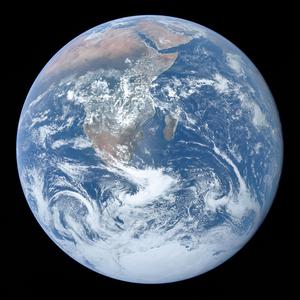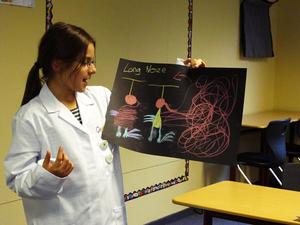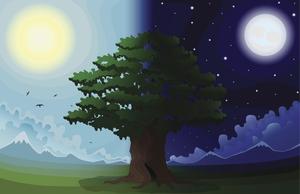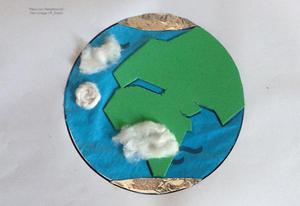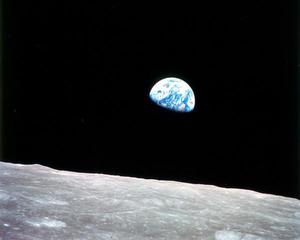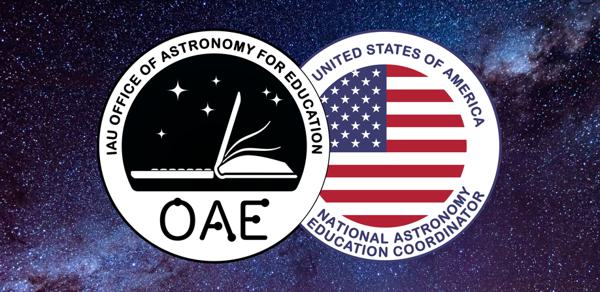Glossary term: Terre
Description: La Terre est la troisième planète à partir du Soleil et la cinquième plus grande planète du système solaire. Il s'agit d'une planète tellurique, rocheuse d'un rayon d'environ 6 400 kilomètres (km). Sa masse est d'environ six mille milliards de milliards de kilogrammes.
La distance typique de la Terre par rapport au Soleil est d'environ 150 millions de kilomètres. Cette distance est définie comme une unité astronomique. La Terre met 365,26 jours pour parcourir son orbite autour du Soleil. La Terre a un satellite naturel, la Lune.
La Terre abrite des millions d'espèces de créatures vivantes, dont l'homme ; c'est le seul endroit connu à ce jour où il y a de la vie dans l'Univers. On pense qu'elle s'est formée il y a environ 4,54 milliards d'années. La Terre possède une atmosphère et une magnétosphère qui bloquent les radiations nocives et permettent ainsi la multiplication des organismes vivants. La Terre possède également beaucoup d'eau en surface (c'est la seule planète du système solaire connue pour cela), ce qui lui donne une couleur bleue.
Related Terms:
See this term in other languages
Term and definition status: The original definition of this term in English have been approved by a research astronomer and a teacher The translation of this term and its definition is still awaiting approval
The OAE Multilingual Glossary is a project of the IAU Office of Astronomy for Education (OAE) in collaboration with the IAU Office of Astronomy Outreach (OAO). The terms and definitions were chosen, written and reviewed by a collective effort from the OAE, the OAE Centers and Nodes, the OAE National Astronomy Education Coordinators (NAECs) and other volunteers. You can find a full list of credits here. All glossary terms and their definitions are released under a Creative Commons CC BY-4.0 license and should be credited to "IAU OAE".
If you notice a factual or translation error in this glossary term or definition then please get in touch.
Related Media
La Terre observée depuis Apollo 17
Credit: NASA/Equipage d'Apollo 17/Archive du Projet Apollo
License: PD Public Domain icons
Related Activities
Design Your Alien
astroEDU educational activity (links to astroEDU website) Description: Design an alien life form suited for an extra-terrestrial world.
License: CC-BY-4.0 Creative Commons Attribution 4.0 International (CC BY 4.0) icons
Tags:
Life
, Environment
, Extra-terrestrial
, Art
, Creativity
, Hands-on
, Alien
Age Ranges:
8-10
, 10-12
Education Level:
Primary
, Secondary
Why Do We Have Day and Night?
astroEDU educational activity (links to astroEDU website) Description: Explore day and night of Earth.
License: CC-BY-4.0 Creative Commons Attribution 4.0 International (CC BY 4.0) icons
Tags:
Tilt
Age Ranges:
6-8
, 8-10
, 10-12
Education Level:
Primary
, Secondary
Areas of Learning:
Modelling
, Structured-inquiry learning
, Social Research
Costs:
Low Cost
Duration:
1 hour 30 mins
Group Size:
Group
Skills:
Asking questions
, Communicating information
Globe at Night Activity Guide
astroEDU educational activity (links to astroEDU website) Description: Learn to observe and record the faintest visible stars to measure the light pollution.
License: CC-BY-4.0 Creative Commons Attribution 4.0 International (CC BY 4.0) icons
Tags:
Hands-on
, Dark skies
, ecology
, Citizen science
Age Ranges:
4-6
, 6-8
, 8-10
, 10-12
, 12-14
, 14-16
, 16-19
, 19+
Education Level:
Informal
, Middle School
, Other
, Primary
, Secondary
, University
Areas of Learning:
Observation based
, Project-based learning
Costs:
Low Cost
Group Size:
Group
Skills:
Communicating information
, Planning and carrying out investigations
Meet Our Home: Planet Earth
astroEDU educational activity (links to astroEDU website) Description: Explore a tactile version of our home, the Earth, with household materials.
License: CC-BY-4.0 Creative Commons Attribution 4.0 International (CC BY 4.0) icons
Tags:
Hands-on
, Model
, Visually Impaired
, Tactile
Age Ranges:
6-8
, 8-10
, 10-12
Education Level:
Middle School
, Primary
, Secondary
Areas of Learning:
Interactive Lecture
, Modelling
Costs:
Low Cost
Duration:
1 hour 30 mins
Group Size:
Group
Skills:
Analysing and interpreting data
, Asking questions
, Communicating information
, Developing and using models
Blue Marble in Empty Space
astroEDU educational activity (links to astroEDU website) Description: Students are taken on a virtual journey to outer space to experience that we live on a tiny planet that floats in a vast and empty space.
License: CC-BY-4.0 Creative Commons Attribution 4.0 International (CC BY 4.0) icons
Tags:
Life
, Hands-on
, Model
, Scales
, Distances
, ISS
Age Ranges:
6-8
, 8-10
Education Level:
Primary
, Secondary
Areas of Learning:
Interactive Lecture
, Modelling
Costs:
Low Cost
Duration:
30 mins
Group Size:
Group
Skills:
Asking questions
, Communicating information
, Developing and using models
